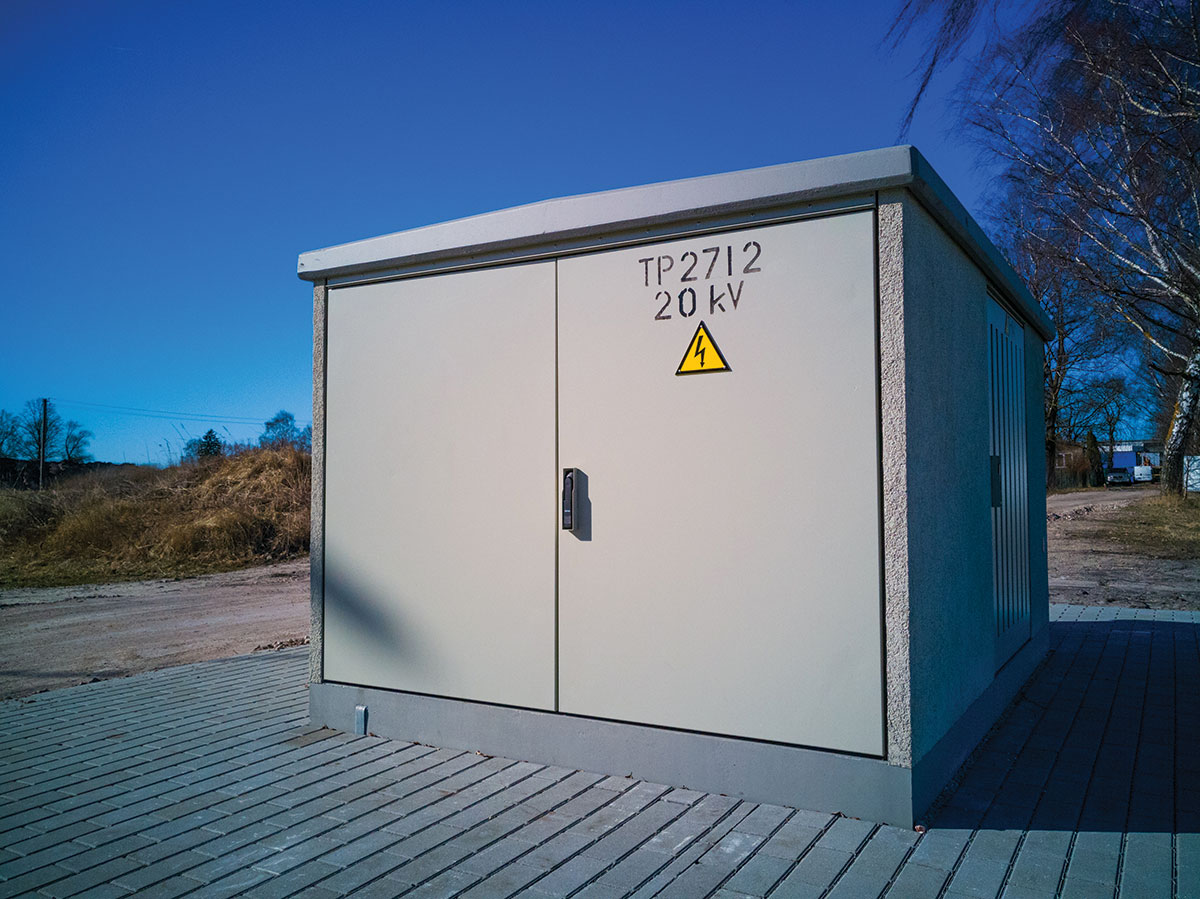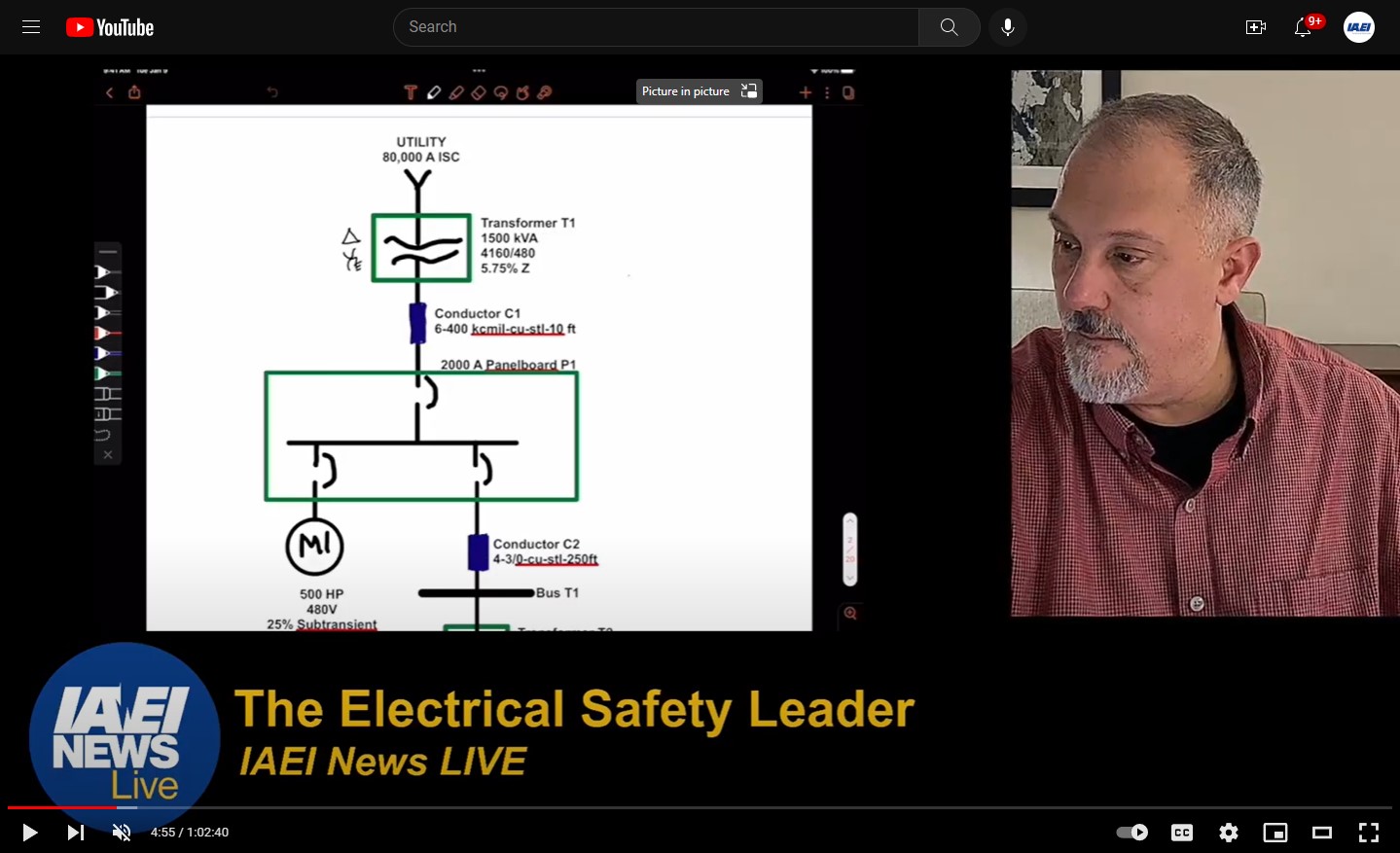An infinite bus short-circuit calculation can be used to determine the maximum short-circuit current on the secondary side of a transformer using only transformer nameplate data. This is a good (and simple) method for determining the worst-case maximum short-circuit current through the transformer since it ignores the source/utility impedance. Ignoring the source impedance means it is assumed to be zero and voltage divided by zero is infinite, hence the often-used term “infinite bus” or “infinite source.”
In my Infinite Bus article at brainfiller.com, the infinite bus method is illustrated to calculate the maximum worst case short-circuit current at the 480 volt secondary of a 1500 kVA transformer with a 5.75 percent impedance. Using the “infinite bus” or “worst case” approach indicated an available short-circuit current of 31,374 amps.
However, what if you are evaluating the adequacy of a panel on the secondary that has a short-circuit rating of 30,000 amps? With the infinite bus approach, it would mean the panel has an inadequate interrupting rating. But does it really? This could be an expensive conclusion based on assumed (infinite primary) data.
Another concern about using the infinite bus approach is if the short-circuit calculations are to be used for an arc flash study. This is something that I discuss in my arc flash training class about using IEEE 1584 to perform arc flash calculations.
With arc flash studies, the higher short-circuit current may result in the worst-case incident energy, but this is not always the case. It is possible that a lower short-circuit current could result in a protective device taking longer to operate which would result in a longer arc flash duration and increase in the total incident energy.
To provide more accurate short-circuit calculations, the source impedance needs to be included. Let’s see how to include the effect of the actual source short-circuit current and the equivalent source impedance. To account for the source impedance, the same formula that was used for the infinite bus solution can be used but a few more steps need to be added.
The infinite bus formula is based on transformer impedance as shown below. It ignores the source impedance:
SCAsecondary = ( FLAsecondary x 100 ) / (%Ztransformer)
Source and Transformer Impedance
The actual short-circuit current available at a transformer’s secondary terminals is not just a function of transformer impedance, but it is also dependent on how strong the source is at the primary of the transformer. A transformer connected to a strong source such as close to a major utility substation, will have a greater secondary short-circuit current than if the same transformer was connected to a weak source such as a long distribution line in a rural area.
To factor in the strength / weakness of the source impedance we only need to add one extra variable, % Zsource to the previous equation.
The new equation would be:
SCAsecondary= ( FLAsecondary x 100 ) / (%Ztransformer + %Zsource)
By adding %Zsource to %Ztransformer the strength of the source is included. A stronger source will have a smaller value for %Zsource and a weaker source will have a larger value.
The calculation procedure is similar to the infinite bus calculation, but we now have to add the additional step of calculating the source impedance.
Step 1 — To calculate the equivalent source impedance:
%Zsource = (kVAtransformer ) / ( kVAshort circuit ) x 100
where:
kVAshort circuit = kVPrimary x Sqrt (3) x SCAprimary
This seems simple enough but where do you obtain the SCAprimary? Great question! If the transformer is going to be connected to the utility system, the utility company is usually the source of this information. It is best to start out by determining who is the utility account representative and ask if they can either provide you with the information or direct you to someone that might have the information.
If the transformer is not directly connected to the utility but is further downstream in a power distribution system, you will need to obtain short-circuit calculations for the upstream part of the system. This means someone (perhaps you) will have to perform short-circuit calculations from the utility down through the power distribution system.
If you are unable to determine any of this information, and you are concerned about worst-case highest magnitude short circuits, you can always default to the simpler and generally more conservative infinite bus calculation.
Care must be taken! Infinite bus calculations are good for the evaluation of the maximum worst-case short-circuit current through the transformer (excluding motor contribution and impedance tolerances for transformers not yet delivered/tested). However, if you are interested in minimum short-circuit currents for analysis such as arc flash, voltage flicker or harmonic resonance, an infinite bus calculation is not the way to go.
Derivation of Step 1
The formula for calculating the source impedance may seem a little odd the first time you see it. Dividing two different kVAs magically becomes an impedance/ However, this method has its origin with the Per Unit System. The %Zsource is actually the true primary source impedance of the source in ohms, divided by the transformer base impedance in ohms. Here is how the derivation of step 1 works:
%Zsource = (Zsource ohms / Ztransformer base) x 100
%Zsource = (kV2Secondary/MVAshort circuit ) / ( kV2secondary/MVAtransformer) x 100
where:
Zsource ohms = kV2secondary / MVAshort circuit
Ztransformer base = kV2secondary / MVAtransformer
The kVsecondary in the numerator and denominator cancel each other and you are left with:
%Zsource= [(1 /MVAshort circuit) / (1 / MVAtransformer)] x 100
which becomes:
%Zsource = (MVAtransformer / MVAshort circuit ) x 100
or in our case we use kilo instead of mega so our numbers are scaled by 1000:
%Zsource = (kVAtransformer / kVAshort circuit) x 100
Step 2 — Calculate the secondary full load current rating of the transformer:
FLAsecondary = kVA3phase / [kVsecondary x Sqrt (3)]
Step 3 — Calculate the short-circuit current on the transformer secondary bus, but this time we use the transformer impedance AND the source impedance.
SCAsecondary = (FLAsecondary x 100) / (% Ztransformer + %Zsource)
Here is an example of the calculation
Let’s say we have a transformer rated 1500 kVA with a secondary voltage of 480Y/277V, a primary voltage of 13.2 kVL-L and an impedance of 5.75%. Suppose the utility informs us that their maximum short-circuit current available at the transformer’s primary is 6,740 amps at 13.2 kV.
Step 1 — Calculate the source impedance:
kVAshort circuit = 6,740 amps x 13.2 kVL-L x sqrt(3)
kVAshort circuit = 154,097 kVA
(some utility companies might refer to this as 154 MVA )
% Zsource = (1500 kVA / 154,097 kVA) x 100
% Zsource = 0.97%
Step 2 — Just like the infinite bus case, calculate the secondary full load current rating of the transformer.
FLAsecondary = 1500 kVA / [0.48 kVL-L x Sqrt (3)]
FLAsecondary = 1804 amps
Step 3 — Calculate the short-circuit current on the transformer secondary bus.
SCAsecondary = (1804 amps x 100) / (5.75% + 0.97%)
SCAsecondary = 26,845 amps
If this calculation ignored the source and assumed it was infinite, the short-circuit current at the secondary would be:
SCAsecondary = 31,374 amps
You can see that factoring in the source impedance (source strength) has a significant effect on the magnitude of short-circuit current at the transformer secondary terminals.
All of the variables listed above are:
FLAsecondary = Secondary full load amps
kVprimary = Primary L-L voltage in kV
kVsecondary = Secondary L-L voltage in kV
kVA 3phase = Transformer three-phase kVA,
self cooled
Sqrt (3) = Square root of three (1.73)
% Ztransformer = Transformer percent impedance
% Zsource = Source percent impedance
referenced to the transformer base
kVAshort circuit = Short-circuit power
SCAsecondary = 3-phase short circuit amps at the secondary bus
SCAprimary = 3-phase short circuit amps at the primary bus
A few more words of caution! The impedance of a transformer must be the actual nameplate and not an assumed value. Impedances of transformers that have not yet been built or tested can vary by + / – 7.5% of the specified impedance. The above calculation does not include motor contribution which will also need to be considered.
Adding the source and transformer impedances like we just did is good for a close approximation, but it is not perfect. The impedances should be added using vector addition which means divide each impedance into its respective X and R value and combine the individual terms to determine the true magnitude of the total impedance. The X/R ratio is the amount of reactance X divided by the amount of resistance R which also happens to be the Tangent of an angle created by reactance and resistance in a circuit.
Source: Reprinted with permission. Brainfiller.com. Short Circuit Calculations with Transformer and Source Impedance. https://brainfiller.com/2018/03/18/short-circuit-calculations-with-transformer-and-source-impedance/ and https://brainfiller.com/2005/08/22/short-circuit-calculations-infinite-bus-method/










Find Us on Socials